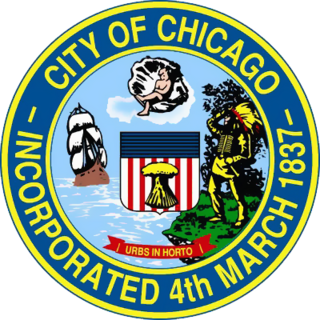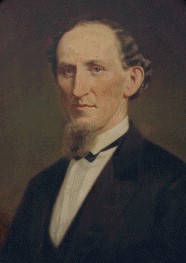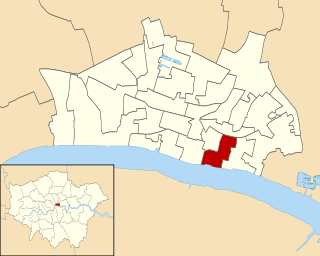An alderman is a member of a municipal assembly or council in many jurisdictions founded upon English law. The term may be titular, denoting a high-ranking member of a borough or county council, a council member chosen by the elected members themselves rather than by popular vote, or a council member elected by voters.

The Chicago City Council is the legislative branch of the government of the City of Chicago in Illinois. It consists of 50 aldermen elected from 50 wards to serve four-year terms. The council is gaveled into session regularly, usually monthly, to consider ordinances, orders, and resolutions whose subject matter includes code changes, utilities, taxes, and many other issues. The Chicago City Council Chambers are located in Chicago City Hall, as are the downtown offices of the individual aldermen and staff.
Kenneth Allen Schmied, a Republican, served as Mayor of Louisville, Kentucky.
Liverpool City Council has existed since 1880, when Liverpool was awarded city status. Prior to this date the local authority was a town council.
The Council Wars were a racially polarized political conflict in the city of Chicago from 1983-1986, centered on the Chicago City Council. The term came from a satirical comedy sketch of the same name written and performed by comedian and journalist Aaron Freeman in 1983, using the good vs. evil plot line of the film Star Wars as a device.

The London Government Act 1899 was an Act of the Parliament of the United Kingdom that reformed the administration of the capital. The Act divided the County of London into 28 metropolitan boroughs, replacing the 41 parish vestries and District Boards of Works administering the area. The legislation also transferred a few powers from the London County Council to the boroughs, and removed a number of boundary anomalies. The first elections to the new boroughs were held on 1 November 1900.

The Louisville Metro Council is the city council of Louisville, Kentucky. It was formally established in January 2003 upon the merger of the former City of Louisville with Jefferson County and replaced the city's Board of Aldermen and the county's Fiscal Court. Louisville City Hall houses the offices and chambers of the council.

The County Borough of Leeds, and its predecessor, the Municipal Borough of Leeds, was a local government district in the West Riding of Yorkshire, England, from 1835 to 1974. Its origin was the ancient borough of Leeds, which was reformed by the Municipal Corporations Act 1835. In 1889, when West Riding County Council was formed, Leeds became a county borough outside the administrative county of the West Riding; and in 1893 the borough gained city status. The borough was extended a number of times, expanding from 21,593 acres (8,738 ha) in 1911 to 40,612 acres (16,435 ha) in 1961; adding in stages the former area of Roundhay, Seacroft, Shadwell and Middleton parishes and gaining other parts of adjacent districts. In 1971 Leeds was the fifth largest county borough by population in England. The county borough was abolished in 1974 and replaced with the larger City of Leeds, a metropolitan district of West Yorkshire.
The government of Louisville, Kentucky, headquartered at Louisville City Hall in Downtown Louisville, is organized under Chapter 67C of the Kentucky Revised Statutes as a First-Class city in the state of Kentucky. Created after the merger of the governments of Louisville, Kentucky and Jefferson County, Kentucky, the city/county government is organized under a mayor-council system. The Mayor is elected to four-year terms and is responsible for the administration of city government. The Louisville Metro Council is a unicameral body consisting of 26 members, each elected from a geographic district, normally for four-year terms. The Mayor is limited to a three consecutive term limit, while members of the Louisville Metro Council are not term limited.

John George Baxter Jr. was the nineteenth (1870–1872) and twenty-first mayor of Louisville, Kentucky.

Charles F. Grainger was Mayor of Louisville, Kentucky from 1901 to 1905. He became president of Grainger & Company, his family's iron foundry.
Henry S. Tyler was Mayor of Louisville, Kentucky from 1891 to 1896. His grandfather, Levi Tyler, was a founding father of Louisville and successful businessman. His family continued to be wealthy and owned, among other properties, Louisville's Tyler Block. Henry Tyler attended Schatlock Hall Military Academy in Minnesota. He returned to Louisville to work as a clerk and bookkeeper and eventually established his own insurance company.

Bridge is a small ward in the City of London and is named from its closeness to London Bridge. Since boundary changes in 2003, Bridge is bounded by the River Thames to the south; Swan Lane and Gracechurch Street to the west; Fenchurch Street to the north; and Rood Lane and Lovat Lane to the east.
The Royal Commission on the Corporation of the City of London was a Royal Commission, established in 1853, which considered the local government arrangements of the City of London and the surrounding metropolitan area.

The Board of Aldermen is the legislative body of the independent City of St. Louis, Missouri. The Board of Aldermen is charged with passing legislation, known as board bills, which after passage of the Board are sent to the Mayor to be signed into law. The Board serves as a check against the mayor in a mayor-council government model. The Board monitors performance of city agencies and makes land use decisions as well as legislating on a variety of other issues. The Board also has sole responsibility for approving the city budget. The presiding officer of the Board is the President, who is elected separately city wide. The President of the Board is the second highest ranking official in the City directly behind the Mayor. The Board is made up of 28 aldermen representing the city's 28 wards. The Board meets in the north wing of City Hall in the Aldermanic Chambers.

The City of London is divided into 25 wards. The City is the historic core of the much wider metropolis of Greater London, with an ancient and sui generis form of local government, which avoided the many local government reforms elsewhere in the country in the 19th and 20th centuries. Unlike other modern-day English local authorities, the City of London Corporation has two council bodies: the now largely ceremonial Court of Aldermen and the Court of Common Council.
An election to the Carmarthenshire County Council was held in March 1937. It was preceded by the 1934 election. Due to the Second World War no elections were held in 1940 and 1943 therefore the 1937 election was followed by the 1946 election.

The New York City Board of Aldermen was a body that was the upper house of New York City's Common Council from 1824 to 1875, the lower house of its Municipal Assembly upon consolidation in 1898 until the charter was amended in 1901 to abolish the Municipal Assembly and its upper house, and its unicameral legislature from 1875 to 1897 and 1902 to 1937. The corresponding lower house was known as the Board of Assistants or the Board of Assistant Aldermen from 1824 to 1875, while the upper house was known as the Council from 1898 to 1901. In 1938 a new charter came into effect that replaced the Board of Aldermen with the New York City Council.

The City of Chicago has held elections to its City Council since its incorporation in 1837. Elections were held annually from 1837 through 1921, biennially from 1923 through 1933, and quadrennially starting in 1935. From 1851 through 1922 the Council was staggered and half of it was chosen at each election, but before 1851 and since 1923 the entire Council has been elected at each election.














